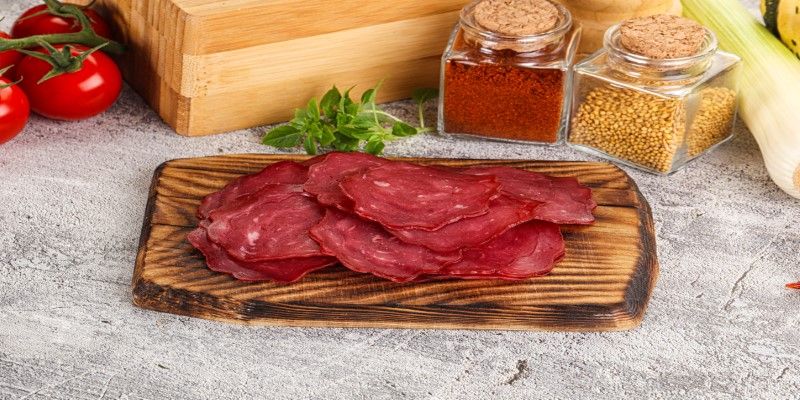Nutritional Breakdown of Pastrami: A Closer Look at This Deli Delight
Mar 12, 2024 By Madison Evans
Pastrami transcends mere deliciousness; it's a culinary emblem cherished for its robust flavor and gratifying texture. Yet, its nutritional essence remains a mystery to many. Here, we explore pastrami's nutritional makeup, unraveling its core elements, extolling its health virtues, and elucidating its seamless integration into diverse dietary regimens. From its irresistible taste to its dietary versatility, delve into pastrami to uncover a balance of indulgence and nourishment that fits snugly into your culinary repertoire.
What is Pastrami?
Pastrami, originating from Eastern Europe and Turkey, has a rich history and intricate preparation, making it more than a deli meat. It traveled to the United States with Jewish immigrants and transformed into the iconic dish we
enjoy today. Crafting pastrami involves selecting quality beef cuts, like brisket or round, and meticulously curing them. The meat is submerged in a seasoned brine to absorb myriad flavors. Then, a spice rub featuring black pepper, coriander, garlic, and mustard seeds is generously applied to enhance its taste complexity.
After the curing and seasoning, the meat is smoked to perfection, infusing it with a smoky aroma and enhancing its depth of flavor. Finally, the pastrami undergoes a slow, gentle steaming process, ensuring tenderness and juiciness in every bite.
The result? It is a tender, juicy delicacy with a compelling blend of savory, peppery, and smoky notes. Pastrami's distinct texture, a harmonious marriage of tender meat and flavorful crust, makes it a standout ingredient in sandwiches, salads, and other culinary creations. Pastrami's versatility knows no bounds, cementing its status as a beloved staple in cuisines worldwide, from traditional deli sandwiches to gourmet dishes.
Nutritional Highlights of Pastrami
Now, let's take a closer look at the nutritional content of pastrami:
Protein:
Pastrami is a good source of protein, with a 3-ounce serving providing around 20-25 grams of protein. Protein is essential for building and repairing tissues in the body, making pastrami a satisfying and nourishing option.
Fat:
The fat content of pastrami varies depending on the cut of meat and how it's prepared. Leaner beef cuts used for pastrami generally contain less fat than fattier cuts. However, it's essential to remember that pastrami may include saturated fat, so it's best enjoyed in moderation.
Sodium:
One of the notable aspects of pastrami's nutrition is its sodium content. The brining process in making pastrami often produces more sodium than other meats. For individuals watching their sodium intake, it's essential to be mindful of portion sizes and balance pastrami with lower-sodium foods.
Vitamins and Minerals:
While not a significant source of vitamins and minerals, pastrami does contain small amounts of essential nutrients such as iron, zinc, and B vitamins. These nutrients play various roles in the body, from supporting immune function to aiding energy metabolism.

Health Benefits of Pastrami
Although often considered an indulgent treat, pastrami can provide specific health benefits when enjoyed in moderation:
Protein Powerhouse:
Pastrami is a protein powerhouse, making it an excellent option for individuals aiming to enhance muscle growth and recovery. Protein is vital for sustaining and building lean muscle mass, contributing to weight management and overall physical strength. Adding pastrami to your meals offers a delicious and convenient method to fulfill your protein requirements.
Iron Boost:
Pastrami serves as an excellent provider of iron, a crucial mineral essential for the efficient transport of oxygen within the body. Insufficient iron levels may result in fatigue, weakness, and diminished cognitive function, emphasizing the importance of maintaining an adequate intake of this nutrient. Incorporating pastrami into your diet can aid in preventing iron deficiency anemia and sustaining optimal energy levels.
Satiety and Weight Management:
With its protein content, pastrami aids in satiety, helping curb the urge to overeat or opt for less nutritious snacks. This is especially advantageous for individuals focused on weight management or adhering to a healthy eating regimen. Integrating pastrami into meals or snacks adds delightful flavor and contributes to achieving and maintaining your weight management objectives.
Flavorful Satisfaction:
Beyond its nutritional benefits, pastrami adds a burst of savory flavor to dishes, enhancing the overall enjoyment of meals. Incorporating flavorful ingredients like pastrami into your diet can make healthy eating more enjoyable and sustainable in the long run, encouraging you to stick to your dietary goals without feeling deprived. Whether enjoyed in a sandwich, salad, or alongside vegetables and whole grains, pastrami can elevate any meal with its rich taste and satisfying texture.

Incorporating Pastrami into Your Diet
Now that we've covered the nutritional aspects of pastrami, you may be wondering how to incorporate it into your diet in a balanced way. Here are some tips:
Portion Control:
Because of its higher sodium content, enjoying pastrami in moderation is essential. Stick to recommended portions, such as 3-ounce servings, and balance pastrami with plenty of fresh vegetables and whole grains.
Choose Lean Cuts:
Opt for pastrami made from leaner cuts of meat to reduce the overall fat content. Look for lean beef or turkey pastrami options, and trim any visible fat before consuming.
Pair with Whole Grains:
Create balanced meals by pairing pastrami with whole-grain bread or wraps. This adds fiber and complex carbohydrates to your meal, helping to keep you feeling full and satisfied.
Conclusion:
In conclusion, pastrami emerges as a culinary gem, offering delectable flavor and nutritional perks when incorporated sensibly into your diet. Its generous protein content aids muscle repair and satiety, while the iron infusion contributes to overall vitality and energy levels. Moreover, pastrami's satisfying taste profile elevates meal experiences, making healthy eating more enjoyable.
To reap its benefits without excess, mindful portion control is critical, ensuring a harmonious balance with other nutrient-rich foods. So, indulge in the savory delight of pastrami, knowing that you're not just savoring its taste but also nourishing your body and fostering a holistic approach to well-being.







